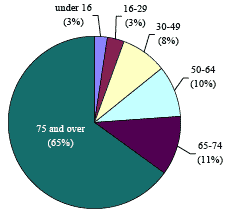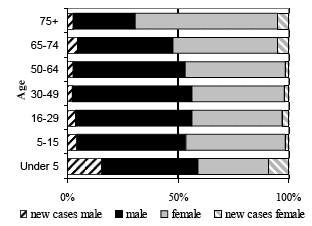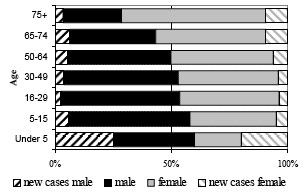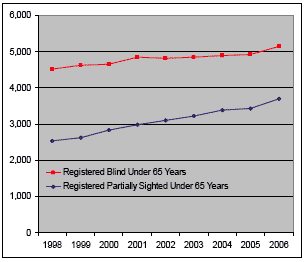Statistics Release: Registered Blind and Partially Sighted Persons, Scotland 2006
The purpose of this statistics release is to present national figures on visually impaired persons registered with Local Authorities in Scotland.
This document is part of a collection
Introduction
The purpose of this Statistics Release is to present national figures on visually impaired persons registered with Local Authorities in Scotland. All figures relate to the 31 st March 2006 and are provisional and, as such, may be subject to change. The final figures will be published in future publications.
Registration with Local Authorities for blind and partially sighted persons is not compulsory. Research studies suggest that between a quarter and a third of visually impaired people are in fact registered with Local Authorities (see background note for more details).
Chart 1: Registered Visually Impaired Persons by Age Group, 2006

Main points
Information collected on visually impaired persons show that: -
- In 2006, the number of people registered as blind or partially sighted was estimated to be just under 37,000
- There were 3,439 cases registered during the period 1 April 2005 to 31 March 2006, down less than 1 per cent on 2005.
- The majority, 58 per cent, of those on the register were blind, 42 per cent were partially sighted.
- 38 per cent of those on the register were male and 62 per cent were female.
- Over three-quarters (76%) of those registered were over the age of 65.
- 11,415 persons (31 per cent) of those registered as visually impaired had additional disabilities. Of these, a quarter were deaf.
Section 1: Blind Persons
There were 21561 registered blind persons in 2006. The number registered blind has shown a drop of 7 per cent over the last year. This continues the trend of small, but steady falls since 2000 (see background note for more details).
The number of new cases registered during the year was 1,512. This is down 10 per cent on the previous year.
The ratio of registered blind per 1,000 population is 4.3 for 2006. (see table 1a).
Table 1a: Number of Registered Blind Persons and New Registrations during the Year 1998-2006
Year 1 |
New Cases |
Total |
Registered per 1000 Pop'n |
|---|---|---|---|
2006 |
1,512 |
21,561 |
4.3 |
2005 |
1,682 |
23,248 |
4.6 |
2004 |
1,566 |
23,172 |
4.6 |
2003 |
1,743 |
23,557 |
4.7 |
2002 |
1,713 |
23,451 |
4.6 |
2001 |
1,766 |
24,748 |
4.9 |
2000 |
1,903 |
24,839 |
4.9 |
1999 |
1,714 |
24,514 |
4.8 |
1998 |
1,796 |
24,096 |
4.7 |
1 Care should be taken when commenting on trends as the fall in numbers between 2000 and 2002 is explained in part by improvements in reporting procedures by some local authoritis.
Source: Registration of Blind and Partially Sighted Persons Return Form SWB
Over three-quarters of registered blind persons are over the age of 65, with two-thirds being over 75. There are significantly more women registered blind (62 per cent) than men (38 per cent).
Almost half (46%) of all registered blind people are women aged 75 and over (see table 1b). This is also reflected in the new registrations where just under half (48%) of the new registered cases are women aged 75 and over.
Excluding the '75 and over' age group there is a much more even split between the sexes. (See Table 1b & Chart 1b).
Table 1b: Number of Registered Blind Persons and New Registrations by Age and Gender, 2006
AGE |
New Cases |
Total |
Total |
||
|---|---|---|---|---|---|
Gender |
Gender |
||||
Male |
Female |
Male |
Female |
||
Under 5 years |
15 |
9 |
57 |
40 |
97 |
5-15 |
15 |
6 |
198 |
173 |
371 |
16-29 |
20 |
17 |
322 |
253 |
575 |
30-49 |
39 |
42 |
1,085 |
843 |
1,928 |
50-64 |
54 |
40 |
1,155 |
1,021 |
2,176 |
65-74 |
100 |
114 |
1,071 |
1,173 |
2,244 |
75 and over |
317 |
724 |
4,341 |
9,829 |
14,170 |
All ages-Total |
560 |
952 |
8,229 |
13,332 |
21,561 |
Souce: Registration of Blind and Partially Sighted Persons Return Form SWB
Chart 1b: Number of Registered Blind Persons and New Registrations by Age and Gender, 2006

An estimated 7,004 (32 per cent) of all registered blind persons have additional disabilities, a quarter of which are deaf. Nearly three-quarters (71%) of those with additional disabilities were over the age of 65 (see Table 1c).
Note that the figures for additional disabilities have increased substantially since last year due to improved reporting by Glasgow.
The ratio of registered blind per 1,000 population is 4.3 for the whole of Scotland. This varies from 1.0 in East Dunbartonshire to 9.2 in the City of Glasgow. The breakdown of this ratio and over 65/under 65 by sex is shown at a local authority level in Annex A on page 9.
Table 1c: Number of Registered Blind Persons with Additional Disabilities by Age, 2006
Additional Disability |
AGE |
Total |
|||
|---|---|---|---|---|---|
Under 5 |
5-15 |
16-64 |
65 and over |
||
Deaf |
1 |
8 |
287 |
1,368 |
1,664 |
Physically Disabled |
12 |
87 |
762 |
2,578 |
3,439 |
Learning Difficulties |
2 |
20 |
337 |
74 |
433 |
Mental Health Problems |
2 |
1 |
225 |
650 |
878 |
Multiple Disabilities |
8 |
66 |
196 |
320 |
590 |
Total |
25 |
182 |
1,807 |
4,990 |
7,004 |
Source: Registration of Blind and Partially Sighted Persons Return Form SWB
Section 2: Partially Sighted Persons
There were an estimated 15,435 registered partially sighted persons in 2006. This is approximately the same as last year.
The number of people registered as partially sighted has been steadily rising over the last 8 years to 2005 with a slight rise in numbers in 2006.
The number of new cases registered during the year was 1,927. This is up 10 per cent on the previous year. The ratio of registered partially sighted per 1,000 population is 3.1 for this year. This has been increasing slightly each year since 1998 (see Table 2a).
Table 2a: Number of Registered Partially Sighted Persons and New Registrations during the years 1998-2006
Year 1 |
New Cases |
Total |
Registered per 1000 Pop'n |
|---|---|---|---|
2006 |
1,927 |
15,435 |
3.1 |
2005 |
1,759 |
15,339 |
3.0 |
2004 |
1,855 |
14,770 |
2.9 |
2003 |
1,748 |
14,443 |
2.9 |
2002 |
2,061 |
13,972 |
2.8 |
2001 |
1,856 |
13,676 |
2.7 |
2000 |
1,776 |
13,287 |
2.6 |
1999 |
1,672 |
12,536 |
2.5 |
1998 |
1,658 |
11,870 |
2.3 |
1 Care should be taken when commenting on trends as the fall in numbers since 2000 is explained in part by improvements in reporting procedures by some local authorities.
Source: Registration of Blind and Partially Sighted Persons Return Form SWB
Data on registered partially sighted individuals shows a similar picture to that of registered blind individuals. Approximately 76 per cent of registered partially sighted persons are over the age of 65, with approximately two-thirds (64%) being aged 75 or over. There are significantly more women registered as partially sighted (64 per cent) than men (36 per cent). Again, just under half (46%) of all registered partially sighted people are women aged 75 and over (see table 2b).
This large proportion of partially sighted women aged 75 or over is also mirrored in the new registrations where 47 per cent of the new registered cases are women aged 75 and over. Excluding the '75 and over' age group there is a much more even split between the sexes (see Table 2b & Chart 2b).
Table 2b: Number of Registered Partially Sighted Persons and New Registrations by Age and Gender, 2006
AGE |
New Cases |
Total |
Total |
||
|---|---|---|---|---|---|
Gender |
Gender |
||||
Male |
Female |
Male |
Female |
||
Under 5 years |
10 |
8 |
24 |
16 |
40 |
5-15 |
26 |
21 |
250 |
182 |
432 |
16-29 |
14 |
21 |
312 |
270 |
582 |
30-49 |
47 |
48 |
643 |
568 |
1,211 |
50-64 |
77 |
88 |
716 |
722 |
1,438 |
65-74 |
114 |
174 |
804 |
1,051 |
1,855 |
75 and over |
355 |
924 |
2,830 |
7,047 |
9,877 |
All ages-Total |
643 |
1,284 |
5,579 |
9,856 |
15,435 |
Souce: Registration of Blind and Partially Sighted Persons Return Form SWB
Chart 2b: Percentage of Registered Partially Sighted Persons and New Registrations by Age and Gender, 2006

An estimated 4,411 (29 per cent) of all registered partially sighted persons have additional disabilities, almost three-quarters (74%) of which are aged 65 and over. Physical disabilities account for over half (55 per cent) and nearly a quarter (22 per cent) are deaf (see Table 2c).
The ratio of registered partially sighted per 1,000 population is 3.1 for the whole of Scotland. This varies from 0.5 in East Dunbartonshire to 5.1 in Argyll and Bute. The breakdown of this ratio and over 65/under 65 by sex, is shown at a local authority level in Annex A on page 9.
Table 2c: Number of Registered Partially Sighted Persons with Additional Disabilities by Age, 2006
Additional Disability |
AGE |
Total |
|||
|---|---|---|---|---|---|
Under 5 |
5-15 |
16-64 |
65 and over |
||
Deaf |
0 |
7 |
112 |
871 |
990 |
Physically Disabled |
3 |
60 |
537 |
1,833 |
2,433 |
Learning Difficulties |
0 |
18 |
147 |
43 |
208 |
Mental Health Problems |
0 |
2 |
107 |
257 |
366 |
Multiple Disabilities |
8 |
34 |
106 |
266 |
414 |
Total |
11 |
121 |
1,009 |
3,270 |
4,411 |
Source: Registration of Blind and Partially Sighted Persons Return Form SWB
Section 3: Visually Impaired Under 65-year-olds
Time series data showing the number of visually impaired people under the age of 65 over the last 8 years is shown in the chart below.
It shows a gradual rise in the number of registered blind persons up until 2001 before remaining relatively constant at between 4,850 and 5,147 from 2001 to 2006. Registered partially sighted persons have increased year on year throughout the 9-year period.
Chart 3: Time Series of Registered Blind and Registered Partially Sighted Persons Aged 65 and Under, 1998-2006

Overall the number of registered visually impaired under 65-year-olds has increased by 6 per cent on last year. The ratio per 1,000 population is at around 2.1 after rising gradually over the past few years (see Table 3a). Data on under 65's by local authority and sex is shown in Annex A on page 6.
Table 3a: Number of Registered Visually Impaired Under 65-year-olds, 1998 - 2006
| Year | No. of Registered Visually Impaired under 65 year olds 1 | Registered under 65's per 1,000 Pop'n of under 65's |
|---|---|---|
2006 |
8,850 |
2.1 |
2005 |
8,354 |
2.0 |
2004 |
8,285 |
2.0 |
2003 |
8,068 |
1.9 |
2002 |
7,928 |
1.9 |
2001 |
7,836 |
1.8 |
2000 |
7,496 |
1.8 |
1999 |
7,250 |
1.7 |
1998 |
7,054 |
1.6 |
1 Data for under 65-year-olds should be more reliable than older age groups due to lower mortality rates.
Source: Registration of Blind and Partially Sighted Persons Return Form SWB
Background Information:
Data was collected on persons registered with local authorities as at 31 March 2006.
The information is derived from returns made to the Scottish Executive by Scottish local authorities. The return asks for the number of blind and partially sighted persons by age, sex and additional disabilities. It does not include persons who may meet the criteria for being blind or partially sighted but have not registered with their local authority.
The Social Work (Scotland) Act 1968 gives local authorities the power to maintain a register of people who are blind or partially sighted. However registration is voluntary and while registration provides access to a number of benefits and concessions there remain a large number of people who meet the criteria but are not registered. Research in 1991 1, undertaken at a UK level, indicated that the number of people on registers is some 23 per cent of those eligible. In 2001 they estimated it to be under a third.
1 Blind and Partially Sighted Adults in Britain: The RNIB Survey, Volume 1, HMSO, 1991
'Think dual sensory' published in 1997 by the Department of Health suggested that some 2,000 people in Scotland could have some degree of deafblindness. Our latest figures show that there are 1,732 people registered as deafblind in Scotland. This would suggest that people are more likely to register if they have multiple disabilities.
Additionally, there are known problems with previous years' data where people have not been removed from the register of blind and partially sighted persons. Many local authorities have in recent years improved their registers by comparing with the register of deaths and this may in part explain the decrease in the number of registered blind persons since 2000.
Returns were received from all local authorities:
Glasgow have substantially revised their figures this year following a move to a new management information system. This has resulted in improvements to data quality for 2006 but care should be taken when comparing 2005 and 2006 figures as many of the changes seen are largely due to changes in the Glasgow figures.
For example, Glasgow have improved their data collection on additional disabilities resulting in an increase in the overall number of visually impaired people with additional disabilities.
Work is still ongoing to improve the Glasgow data and 2007 should show further improvements in this data.
Fife and Scottish Borders were unable to provide complete information on additional disabilities. Care should therefore be taken when interpreting figures as a small amount of data has been estimated for these 2 local authorities.
East Dunbartonshire has undertaken a data cleaning exercise this year which has resulted in significant decreases in the number of people registered as visually impaired.
2002 based population projections from GRO(S) have been used to calculate rates per 1000 population in this Statistics Release.
Further Information
Further details and analysis of the data presented in this Statistics Release are available on request from the address given below. The Statistics Release is available in large print and on the Internet by accessing the Scottish Executive web site ( www.scotland.gov.uk).
Community Care StatisticsRoom 3WR
St Andrew's House
Regent Road
Edinburgh
EH1 3DG
Contact: Steven Gillespie
Tel: 0131 244 3777
E-mail: SWStat@scotland.gov.uk
This statistics release was published on 31 October 2006.
There is a problem
Thanks for your feedback